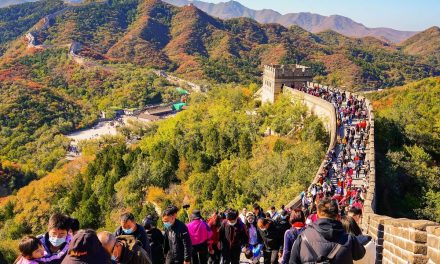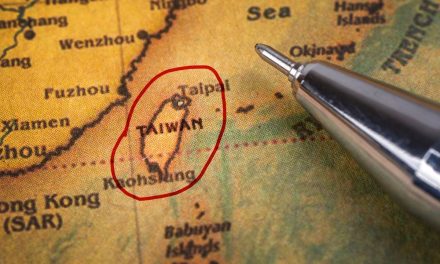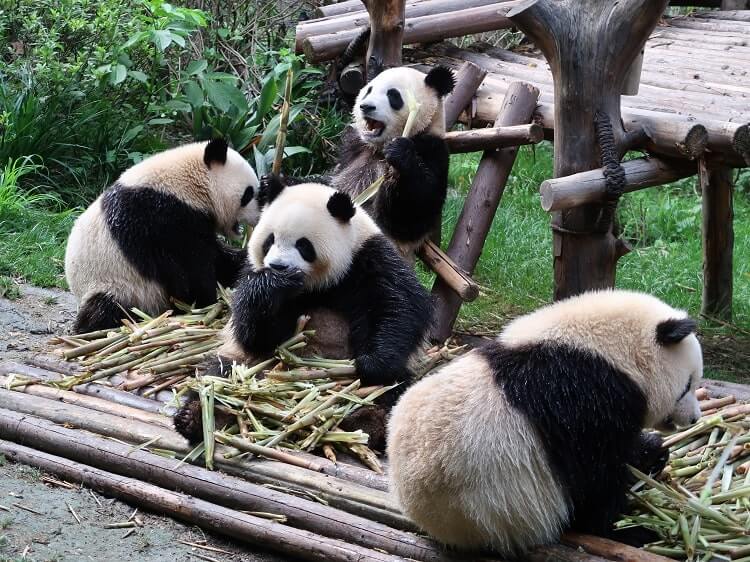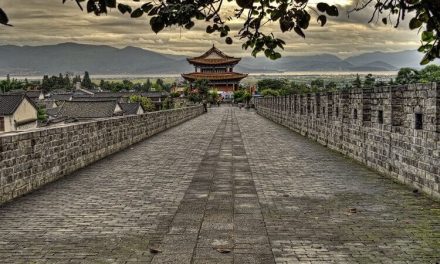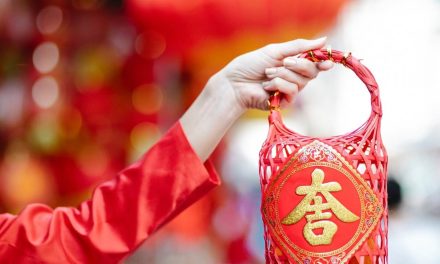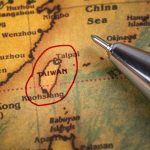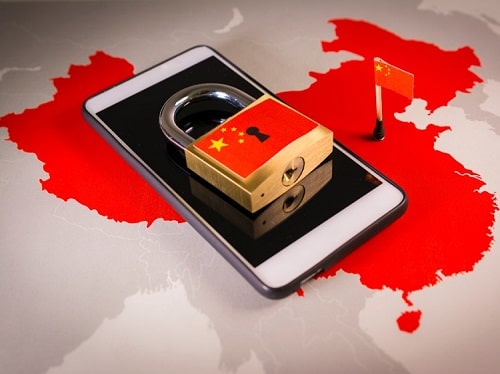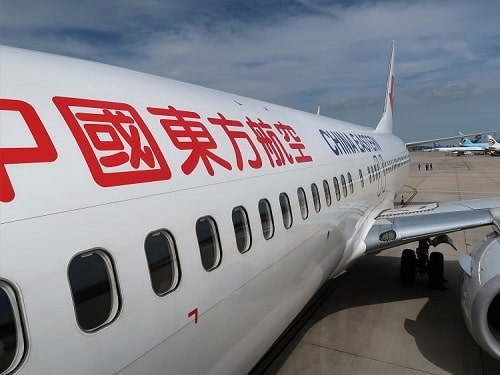How much do you actually know about China?
This country has only fairly recently come onto the international travel stage and not many people have explored it thoroughly.
Added to that, China is simply huge and home to an enormous variety of people and cultures.
If you want to learn more about this massive country for your next trip or just to be well informed, then here’s a list of the top 18 things that China is most known and famous for.
1. The Great Wall of China

The Great Wall is China’s most famous landmark. Image supplied by Mike Cairnduff.
The Great Wall of China is one of China’s most popular and famous tourist attractions. It was built over hundreds of years and had to be rebuilt several times, so parts of the wall are younger than others.
The Great Wall stretches over 13,000 miles across China and was built as a deterrent to invaders. It’s now known as one of the new Seven Wonders of the World and a marvel of military architecture.
You can see the wall from various spots across China, though the best areas are north of Beijing.
During my trip to the northern section of the wall, I was absolutely astonished to stand on the wall as it ran along the steep mountain ridges and take in the spectacular views across the landscape.
Oh, and you can’t see the Great Wall from outer space. It’s a myth!
2. Martial arts
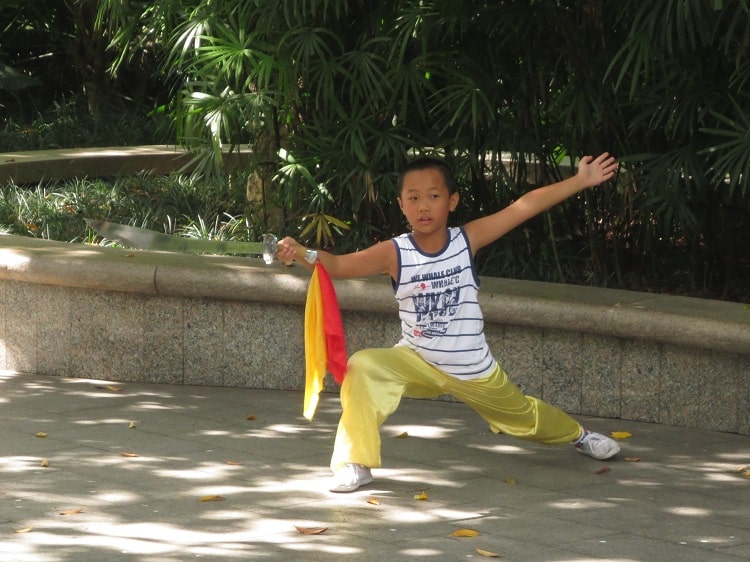
Martial arts are huge in China. Image supplied by Mike Cairnduff.
Chinese martial arts can be traced back to the Xia Dynasty, some 4000 years ago. Otherwise known as wushu, they were created for ancient Chinese soldiers, to give them a way to fight hand-to-hand in combat.
Traditionally, martial arts were created by the Yellow Emperor, Huangdi, who was said to be a famous general, intellectual and inventor.
Over the years, these ancient martial arts diverted to include different philosophies, ideas and purposes. Today, Chinese martial arts are used for self-defense, health, and to expand the mind, and there are loads of different styles.
The most famous is Shaolin-style kung fu, which was brought to China by the founder of Chinese Buddhism and was originally practiced by monks.
If you’re interested in kung fu, then you can go to China and learn it at one of the many kung fu teaching temples.
3. Chinese food
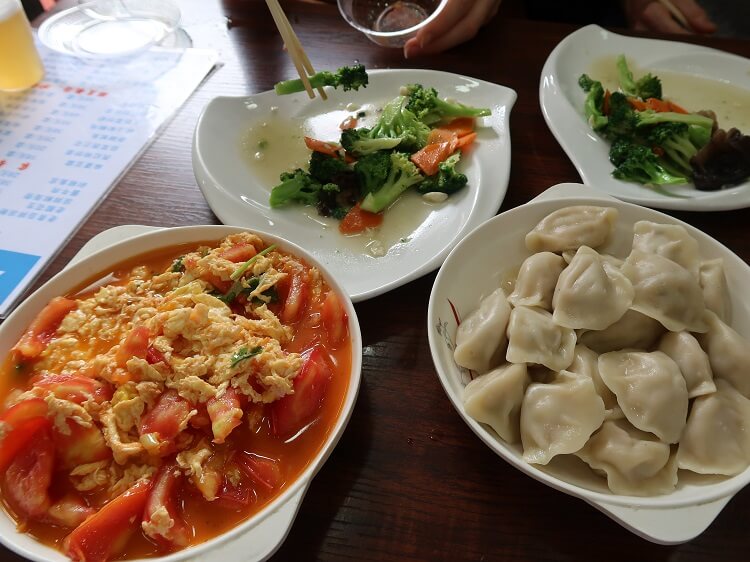
China is known for its delicious and varied food. Image supplied by Mike Cairnduff.
Food in China is not like what you’ll enjoy back home. China is home to a huge variety of cuisines, with each region having their own dishes, styles and cooking traditions.
If you go to China expecting to find dishes that are your favorites back home, then you may be surprised. On Chinese menus, you’ll find everything from spicy soup and chicken feet to boiled fish eyes, so make sure you really know what you’re ordering.
But don’t be afraid to try things either. When I was in China, I found the hot, crispy duck feet to be a surprisingly tasty snack!
Most Chinese food that’s found outside of China follows the Cantonese cooking style and traditions. This means that when you arrive in China, you’ll have a huge range of cuisines to try that you may not have even heard of before.
One of the most famous of all Chinese foods is dumplings. These little bundles of warmth are eaten all over the country, but the ingredients and way they’re cooked differs depending on where you are in the country.
I’ve written a guide specifically about dumplings in China if you’d like to learn more.
4. Terracotta Warriors

The Terracotta Warriors are quintessentially Chinese. Image by Janeb13 on Pixabay.
Located near the city of Xi’an, the Terracotta Army Museum is considered one of the greatest archaeological sites in the world.
The army was constructed to guard the tomb of China’s First Emperor. Emperor Qin reigned between 221 and 210 BCE and was the creator of the first unified Chinese empire, which collapsed just four years after his death.
He was also known as a bit of a megalomaniac and had many enemies, which is why the life-sized soldiers of the Terracotta Army were created to guard his tomb.
The statues are amazingly detailed and number in their thousands. They each have their own hairstyles and facial expressions and were posed and painted to look like individual people. This must have been a monumental task!
5. Silk

China is famous for silk production. Image supplied by Mike Cairnduff.
China was once the sole keeper of the secret of making silk. Because it couldn’t be made in the West for a long time, silk quickly became one of the most valuable commodities in the ancient world and was once worn solely by royalty.
It was transported from East to West along the Silk Road, an ancient trading route that originally carried goods from Rome to China and back again.
The secrets of making silk were stolen from China in 550 AD. According to the stories, two monks smuggled silkworm eggs out of China in a bamboo pole.
The monks presented the silkworms to Byzantine Emperor Justinian I in Constantinople, who created a thriving silk industry. From there, the secrets of silk making slowly spread across the world.
Today, you can buy silk clothes almost anywhere. But there’s nothing like buying silk from the place of its birth such as a beautiful Cheongsam dress, a modernized version of China’s traditional dress.
But if you always seem to be on a budget like me, you could go for a silk scarf. It’s much more affordable!
Most of the group tours in China will take you to a silk factory.
6. Pandas

The Panda Research Base in Chengdu. Image supplied by Mike Cairnduff.
The black and white panda is the emblem of China. Weighing up to 200 pounds, these cute creatures are slow moving and gentle.
Pandas are notoriously difficult to keep alive. They don’t breed well and they live off bamboo, which they can’t digest properly. They’re also threatened by habitat loss.
There are still some pandas in the wild, but it’s easier if you see them in one of the many breeding centers in and around Chengdu, such as:
There are numerous other wild animals in China but the panda is by far the most famous.
7. Calligraphy

China is known for beautiful calligraphy. Image by PublicDomainPictures from Pixabay.
Calligraphy was once one of the four arts, four talents that all aristocratic Chinese scholars were meant to possess in the ancient world. The other three were mastery of the qin (a stringed musical instrument), Chinese painting, and qi (the game of Go).
In the ancient world, Chinese calligraphy was used as a writing and meditative practice as well as an art form.
It was often performed in combination with Chinese painting and has origins in oracle bone script. This is an early form of writing in China that predicted the future through writing prophecies on animal bones.
Today, calligraphy is mostly an art form and masters practice it for years to become proficient. It’s also being used, somewhat subversively, in rebel art.
The Yangjiang Group in particular is known for this and experiment with breaking the rules of calligraphy in their artwork.
8. Tea
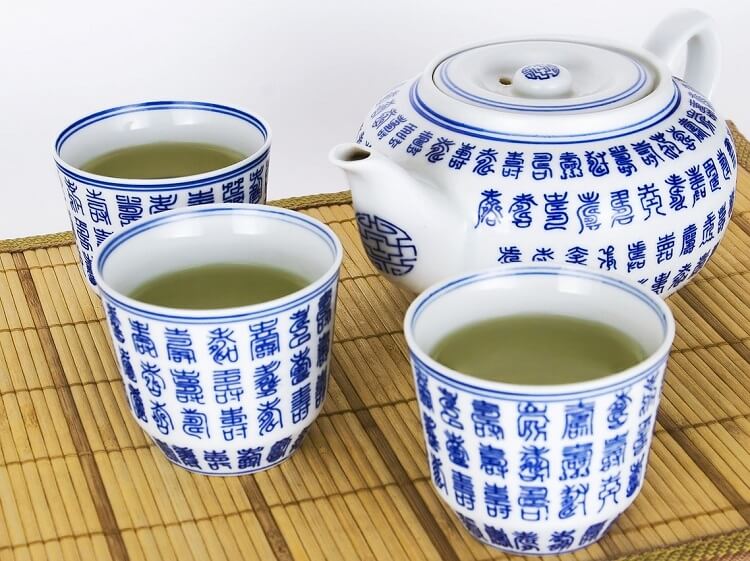
Tea is the national drink. Image by Gadost0 on Pixabay.
Tea is an inseparable part of Chinese culture. It has been a popular drink in China for more than 5,000 years, which is why you’ll still find traditional teahouses in almost every city.
These teahouses are more than a place to drink tea though, they’re also a place to sit, listen to stories, and enjoy live entertainment with your beverage.
Tea in China is more than a delicious drop. It’s also a medicinal drink, and if you go into a tea house then you’ll find people drinking tea that’s meant to alleviate certain health complaints.
You may have trouble deciding what type of tea to enjoy while you’re in China, as there are numerous different types that vary by city, region and taste. Here are a few that you could try while you’re in China:
- Bìluóchūn 碧螺春, which is a green tea found mostly in Jiangsu
- Xīhú lóngjǐng 西湖龙井, a cooling, fresh-tasting green tea found in Zhejiang
- Wǔyí yán chá 武夷岩茶, an oolong tea from Fujian that’s full of nutrients and B vitamins
- Xìnyáng máojiān 信阳毛尖, a green tea from Henan that has a strong taste and relaxing effects.
Not sure where these places are? Learn more about the provinces and regions of China.
9. Chinese Zodiac

The dragon is one of the most famous animals in the zodiac. Image supplied by Mike Cairnduff.
The Chinese Zodiac is much more important to people in China than astrology tends to be to people from other countries.
It’s made up of 12 animals that are said to have become part of the zodiac at the direction of the Buddha. Apparently, he invited every animal in the world to meet him and only 12 animals showed up, so he made them into the zodiac.
The Chinese Zodiac animals mark the Chinese years, and you’ll find that most people in China know their zodiac sign. Each sign is associated with numbers, occupations, colors, and places and some of them are more strongly associated with favorable characteristics than others.
For instance, the zodiac sign of the dragon is associated with leadership and power. You can read more about the zodiac animals which are an important part of Chinese New Year.
10. Enormous population
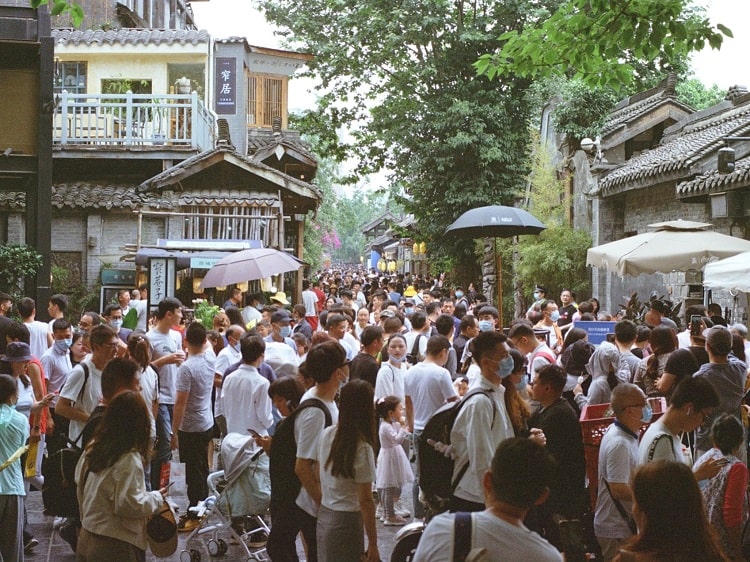
Big population means big crowds! Image by Ulrich & Mareli Aspeling on Unsplash.
China is one of the most populated countries on earth, with over 1.4 billion people at last count. Only India has more people.
The most heavily populated areas are on the eastern seaboard, including Shanghai and Beijing, but there are some huge cities in central China too like Chongqing.
The far west of the country, however, is sparsely populated. It’s home to vast plains and mountains, and borders several countries including Nepal and Kazakhstan.
China’s population is now slowing down. This is due to a number of factors including the one-child policy which lasted decades and dictated how many babies a family could have.
11. Megacities

Shanghai is China’s biggest megacity. Image by Edward He on Unsplash.
With such a huge population, where do so many Chinese people live? Megacities!
Since the start of China’s rapid industrialization, countless people have moved from the countryside to large urban centers in search of work and better salaries.
This has led to cities becoming bigger and bigger, particularly in the last 40 years or so.
The definition of megacity differs depending on who you ask, but according to UNESCO there are six megacities in China:
- Shanghai – 27 million
- Beijing – 20 million
- Chongqing – 15 million
- Tianjin – 13 million
- Guangzhou – 13 million
- Shenzhen – 12 million.
And if current estimates are correct, the cities of Chengdu, Xi’an, Wuhan and Nanjing will become megacities by 2030.
12. Four Great Inventions
Collectively, paper, printing, gunpowder and the compass are known as the Four Great Inventions. And they all originated in China!
The Chinese invented paper around the start of the second century. It’s said that court eunuch Cai Lun was behind the invention, which involved a mixture of things like tree bark, hemp, fishing nets and old linens.
The first ancient forms of printing started in China. First, woodblock printing was used in China as early as 220 AD to print on cloth, and then paper. Centuries later, around 1040 AD, movable type printing was invented. The technology uses movable components to reproduce elements of a document.
Chinese chemists accidentally invented gunpowder when they tried to come up with a potion for immortality. Instead, what they created was a flammable powder. Records in 1044 show recipes for gunpowder.
And, the Chinese invented the magnetic compass that we know today. You can learn more about the greatest Chinese inventions including the four big ones.
13. Confucius

Confucianism runs deep in China. Image by Peggy and Marco Lachmann-Anke on Pixabay.
You’ve probably read or at least heard about some of the sayings of Confucius. He was one of the greatest philosophers in history and his teachings are still famous in China today.
Confucius was a teacher, reformer, and philosopher who was born in 551 BCE and died around 479 BCE. He leaned strongly towards learning as a virtue, which led China towards a high literacy rate and a focus on education long before the rest of the world adopted these philosophies.
Confucius also left behind some very pithy sayings that reveal interesting truths about life and the world. One of my favorites, and one that’s relevant to this article, is “Roads were made for journeys, not destinations.” Isn’t that a great way to look at life and travel?
Confucius isn’t the only famous Chinese person. Learn more about prominent Chinese people.
14. The Forbidden City

Tourists love The Forbidden City. Image supplied by Mike Cairnduff.
If you like palaces, then you’ll love The Forbidden City. I think it’s one of the best places to visit in China.
Built during the Ming dynasty, The Forbidden City is located in Beijing and is also known as the Imperial Palace.
It’s a huge complex, containing more than 980 buildings, and was designed so that the emperor in residence never had to leave or mix with ordinary people.
To get to The Forbidden City, you’ll have to walk through the notorious Tiananmen Square. Today, The Forbidden City is a UNESCO World Heritage site and home to one of the best museums in all of China.
15. Hutongs
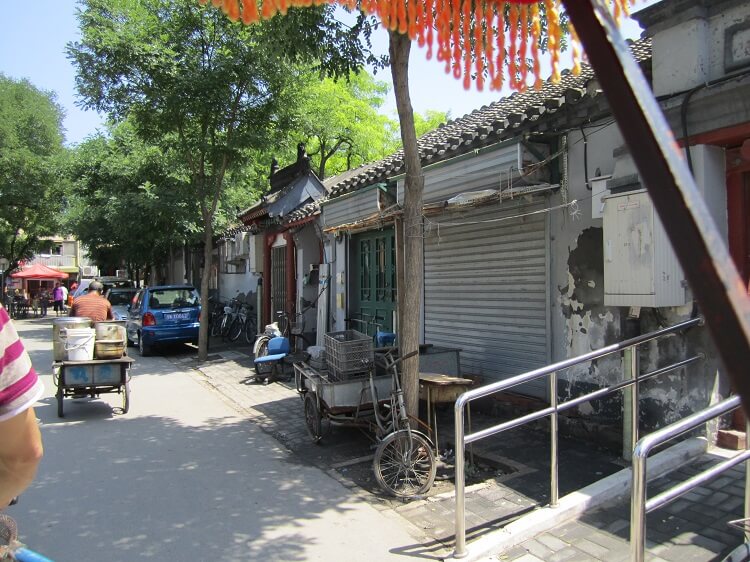
Beijing is known for hutongs. Image supplied by Mike Cairnduff.
Also located in Beijing are the hutongs, or back alleys.
For centuries, the city was made up of countless skinny alleyways, where families lived and small businesses thrived.
When Beijing modernized, however, many of the hutongs were destroyed to make way for enormous skyscrapers made of concrete and glass.
Luckily, some of the hutongs still remain and are a tourist favorite. You can take tours through the alleys and even stay in quaint accommodations which still have the ancient central courtyard layout.
16. Ice Festival
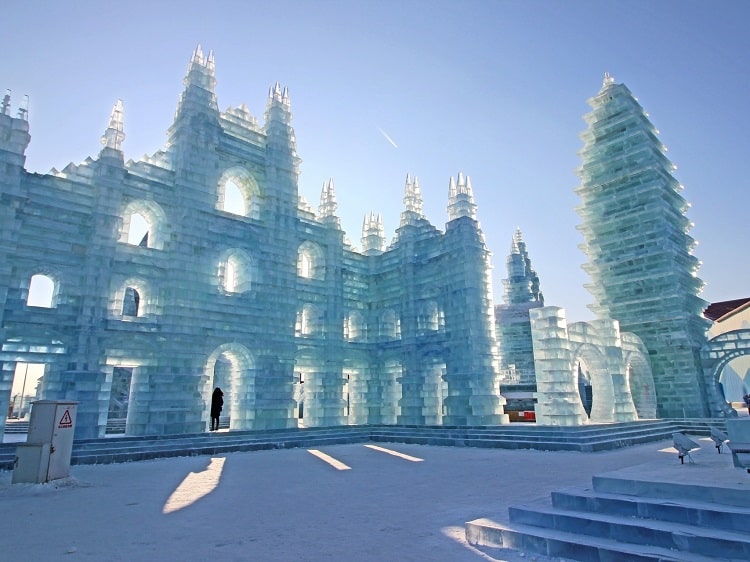
Harbin’s famous Ice Festival draws in people from around the world. Image by Erica Li on Unsplash.
Located in northeastern China in Heilongjiang province, Harbin is the most northern city in China. It’s on the Chinese border with Russia and was actually built by the Russians, giving it a distinctly Russian flavor.
Harbin is home to the Ice Festival, one of the most famous winter festivals in the world. One of the highlights of the event is the ice carving festival.
Every year, numerous sculptors travel to Harbin to participate in this Chinese festival and create everything from giant ice palaces to enormous ice buildings created to resemble an actual city.
If you get tired of the ice carvings, then you can always participate in other winter activities like skiing, snowboarding, skating or dog sledding.
17. Epicenter of the COVID-19 outbreak
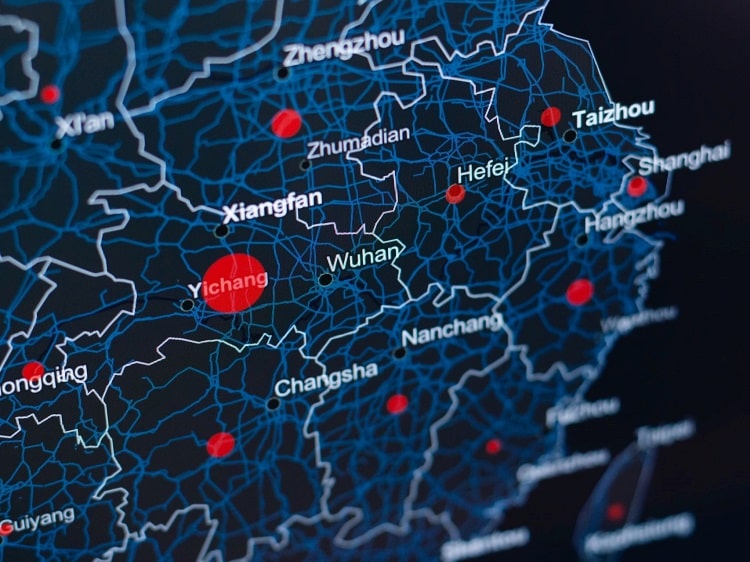
The coronavirus put Wuhan on the map. Image by KOBU Agency on Unsplash.
OK, this one is a little bit morbid. But for many people, it’s what springs to mind when asked “What is China known for?”
Prior to the COVID-19 pandemic, the central Chinese city of Wuhan wasn’t known to many foreigners.
But that all changed in early 2020, when the coronavirus was detected in this city of over 11 million people. As the virus spread around the world, Wuhan was really put on the map!
The outbreak can be traced back to a massive market in Wuhan that sold live animals, called Huanan Seafood Wholesale Market. It was at this wet market where the virus jumped from animals to humans, according to some studies, ultimately affecting the lives of billions of people around the world.
In addition, China was the last country in the world to open up following the pandemic.
18. Summer and Winter Olympics host

The iconic Bird’s Nest Stadium in Beijing. Image by Fandy Zhang on Pixabay.
Following the 2022 Winter Olympics, Beijing became the first city to have hosted both the winter and summer games.
Previously, the summer Olympics took place there in 2008. The games began on an auspicious date: the eighth day of the eighth month.
The number eight (bā) is deemed lucky in China because it sounds similar to the word for fortune (fā).
If you’re interested, you can read more fun facts about China here.
Heading to China soon?
If you’re planning a trip to China, don’t forget the internet is censored there.
So, when using Wi-Fi, you won’t have access to your favorite sites and apps like Instagram, Facebook, YouTube, Gmail, Google and heaps more, unless you get a VPN before you arrive.
Please refer to this helpful review for the best China VPN (or skip the review and go straight here).
Just make sure you download it before you arrive as VPN sales are blocked in China.
What are China’s cities known and famous for?
Find out all the special things about China’s most iconic cities:
The takeaway
China has so many incredible things to see and experience. Some of them you might have heard about, while others are a little more obscure.
If you’re headed for China and want to have a truly immersive experience, I highly recommend going deeper than the typical Chinese tourist attractions.
It might make your trip a bit harder, but it’s totally worth the effort.
Keep reading
I’ve only just scratched the surface on China and what makes the country stand out.
Keep reading about some other interesting and amazing things about China:
Main image credit: Supplied by Mike Cairnduff.
FAQ about what China is known and famous for
What is China famous for?
China is famous for a whole bunch of things, the most prominent being The Great Wall of China, pandas, Chinese food, tea and silk.
What are China’s famous landmarks?
The Great Wall of China is the country’s most famous landmark as it stretches for thousands of miles across multiple provinces, followed by the Terracotta Warriors in Xi’an. Beijing is home to the Forbidden City and Summer Palace, while Shanghai is famous for The Bund and the country’s highest skyscrapers.
What is China famous for producing?
China is known as ‘The World’s Factory’ and produces industrial goods like steel and cement as well as consumer products like cars, computers and cellphones.
What is China’s famous food?
China is home to many famous foods, the most famous being rice, noodles and dumplings.


